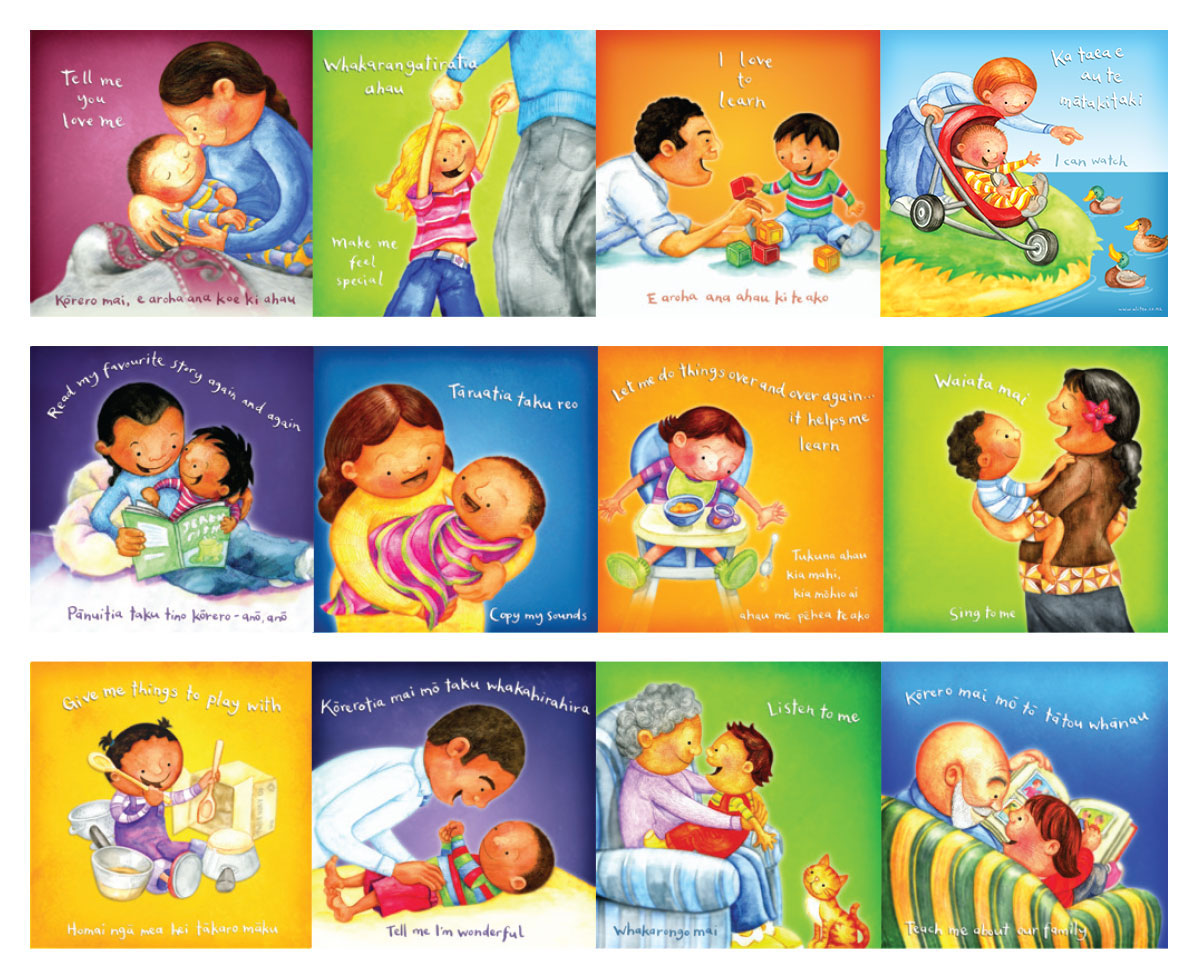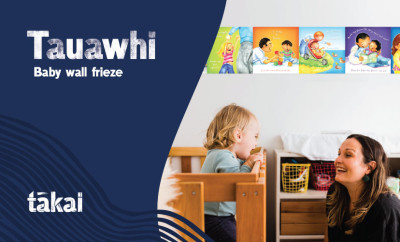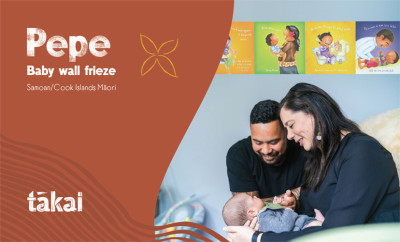
Tākai baby wall frieze
The baby frieze has 12 pictures that show easy ways to build a strong relationship between whānau and pēpi up until around 2 years. It will help parents think about developing their baby's brain before and after pēpi is born.
The most important thing parents can do for their baby is to love them and build a strong relationship with them. This is how baby’s brain is built and strengthened.
All the activities on the baby frieze show how we do that. Doing these simple things, and repeating them, will build a healthy brain.
Building baby’s brain
When pēpi is born, organs like the heart and liver have finished developing – they just need to grow bigger. But the brain is not finished. It has millions of cells already, but most of them are not connected. Repeated experiences help the brain’s connections mature and function properly.
A loving relationship is the key to building a healthy foundation for all future learning, behaviour and health. It gives baby a strong, positive emotional basis to build on, and helps in the wiring of a strong brain.
Simple, everyday interactions, stimulate babies’ brain cells to connect – this creates what are called neural pathways. By repeating the interactions, these pathways are strengthened.
Tamariki need positive experiences to build a healthy brain. It’s the responsibility of the adults around them to help make this happen.
Things to start with
Even without the frieze, there are things parents can do to start living and thinking about the messages it shares. Doing these things will add to their child’s wellbeing and happiness.
For example, even with their new baby they can:
- say "I love you" and "You are wonderful"
- sing to them
- read baby a favourite story, again and again.
And if baby is a bit older, parents could try to:
- get down on the floor with them and play with blocks or toys
- take a walk to a park or playground
- snuggle up and read a story together
- sing a song with them.
During their pregnancy, remind them that pēpi can hear them and loves listening to their special voices. Suggest they read a story, say a rhyme, or sing a particular song over and over again to their unborn baby. Pēpi will recognise that story, rhyme or song after they are born.
How to use the frieze
Mention the baby frieze to whānau and offer to give them one for baby’s room. Tell them that:
- although it’s very attractive, it’s not just a decoration
- there are many important messages on it
- the messages apply to both babies and children – they aren’t just for the ages shown in the pictures
- you’ll talk about the messages in the frieze with them throughout their child’s growth.
You can give the full frieze to whānau, or you could break the frames down and talk about them one at a time. Depending on how you decide to share the frieze, make sure you have a conversation focusing on the message in each image.
When you talk about any one of the pictures on the frieze with whānau, see if it might be a starting point for making some small but positive changes. A good way to do this is to help parents identify something they could do every day. Encourage them to leave their worries aside for a few moments and concentrate on their child.
Conversation ideas
Understanding the messages on the frieze
The messages on the frieze are ‘from baby’. They’re designed to tell whānau about the things that are good for them. If parents follow those prompts every day, they will strengthen their relationship with baby and help baby’s brain to grow.
Kōrero mai, e aroha ana koe ki ahau – Tell me you love me
- If I’m crying and you try to comfort me, I learn to trust you and my world.
- When you hold me and feed me, I learn to trust you and my world.
- When you sing to me and rock me gently, I learn to trust you and my world.
Waiata mai – Sing to me
- I like the words, the tune, the rhythm, the movement and the repetition.
- Did you know that singing releases endorphins – ‘feel good’ hormones?
- Singing helps me learn language. It helps my memory. I learn about our culture and I learn about rhythm and patterns. I learn best when I’m interested and when you make my life interesting.
Tāruatia taku reo – Copy my sounds
- When I talk to you and then you talk to me, I know we belong together.
- I learn that people take turns when they’re talking. You’re teaching me about conversations.
- My brain makes connections for language best when we talk face-to-face.
Pānuitia taku tino kōrero, anō, anō – Read my favourite story again and again
- I love it when you hold me and we read a book — I hear your voice, I feel you close and we share the story together.
- I like hearing my favourite story over and over, because I know how it goes and I like how it’s the same every time you read it.
- Connections in my brain for understanding language work better when I see the pictures and hear you talk about them at the same time.
Pānuitia taku tino kōrero, anō, anō – Read my favourite story again and again
Kōrerotia mai mō taku whakahirahira – Tell me I’m wonderful
- At birth, my brain prefers the sound of human voices above all other sounds, and I can recognise voices I heard when I was in the womb — I’ve made connections for that before I was born.
- When you gaze at me and I gaze at you, I know I’m loved.
- When I hear your voice talking softly to me, I know you’re near and I feel safe.
- When you tell me I’m wonderful, I feel wonderful and I think our world is all right.
Whakarongo mai – Listen to me
- I try to tell you how I’m feeling using my face, my body, my cries and other sounds.
- When you keep trying to understand what I’m trying to tell you, I feel okay about who I am.
- If I cry, I need you to try to fix something.
- When you respond lovingly to me, it helps my brain make connections for handling my emotions, and I learn to trust my world.
Homai ngā mea hei tākaro māku – Give me things to play with
- Whenever I’m playing, I’m learning.
- My brain gets information as I explore things with my senses. I learn a lot in my first year about what things are by putting them in my mouth.
Tukuna ahau kia mahi, kia mōhio ai ahau me pēhea te ako – Let me do things over and over again
- Repeating experiences makes those pathways in my brain stronger.
- Because of all those new connections my brain is making, it’s growing bigger.
Tukuna ahau kia mahi, kia mōhio ai ahau me pēhea te ako – Let me do things over and over again
Whakarangatiratia ahau – Make me feel special
- I need to know that someone loves me, no matter what.
- If I’ve learned to trust my world, I will be much more curious and confident to explore.
- Stress is toxic to my brain, because stress hormones can destroy the connections I’ve made.
Kōrero mai mō tō tātou whānau – Teach me about our family
- Then I know I am not alone.
- I learn best from the people who love and care about me – I’ve learned to trust them.
- When I’m born, I can easily learn 2 or more languages – as long as I hear them spoken to me regularly.
E aroha ana ahau ki te ako – I love to learn
- Everything I see, hear, smell, touch and taste helps my brain cells to connect into pathways.
- At birth, my brain is unfinished. It needs lots of input from my world to connect and develop.
Ka taea e au te mātakitaki – I can watch
- I’ll copy what I see you do and what I hear you say.
- Much of my learning comes from what I see.
- By 12 months, my eyes, my hands and my brain are working together, and I can see as well as most grown-ups.
Helpful resources for whānau
-
Growing great brains<
Growing great brainsJason Tiatia from the Brainwave Trust shares some tips on helping pēpi grow great brains.














